Post by Joshua M. Smith on Dec 17, 2005 19:51:48 GMT -5
Test 1 of the Federal Expanding Full Metal Jacket 124 grain +P 9mm
For those not familiar with the Federal Expanding Full Metal Jacket (EFMJ), it is what its name implies: a full metal jacketed round which expands. It does this via a rubber plug in the nose. Upon impact the rubber (actually silicone) presses against prestressed scored lines in the jacket, causing deformation and expansion. This renders the bullet immune to weaknesses from which a traditional hollow point bullet suffers, namely the ability to be clogged by cloth.
I am aware of two weights in 9mm caliber as of this point in time, 105 grain and 124 grain. I have heard rumors of a 115 grain version but have not seen it. The 105 grain is readily available to the public. I had been told that the 124 grain is primarily law enforcement. Gary at Federal Cartridge confirmed this. He did add however that they do not restrict sales to non - law enforcement as do some other companies and that it can be ordered through a law enforcement supply shop should one not wish to be “stuck with” the 105 grain option.
One of the cartridge’s claims to fame is the ability to penetrate barriers. Today I set out to test this.
The firearm used was my pet pistol, a 1991 vintage Taurus PT92. This is a pre-decock version and, as such, I often carry it in single action with the safety engaged, i.e., “cocked’n’locked”. I save the double action trigger for more politically correct functions: Whenever I’m in town.

The first item tested was accuracy. I need to know that my pistol will shoot a particular round before I trust my life to it. I therefore set a target at a paced seven yards.
I feel seven yards is more than adequate. I debated on using an actual tape measure; I decided, however, to pace it off as real world encounters are rarely measured. I stuck to my semi-controlled stance for the duration of this test.
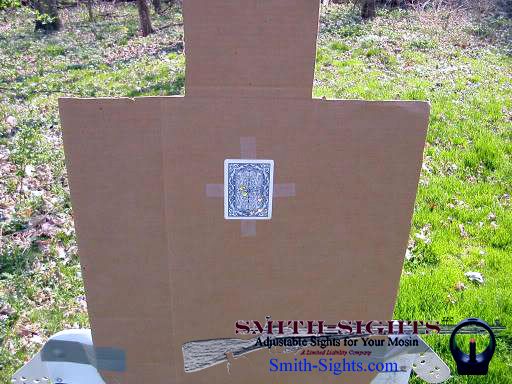
This is what the rounds did in my hands, from my pistol. They are not as accurate as some other rounds I’ve fired. However, I believe they are plenty accurate for serious work and I am therefore carrying them at the moment.
Five shots were fired for accuracy from a Weaver stance. I’ll let the pictures speak for themselves.
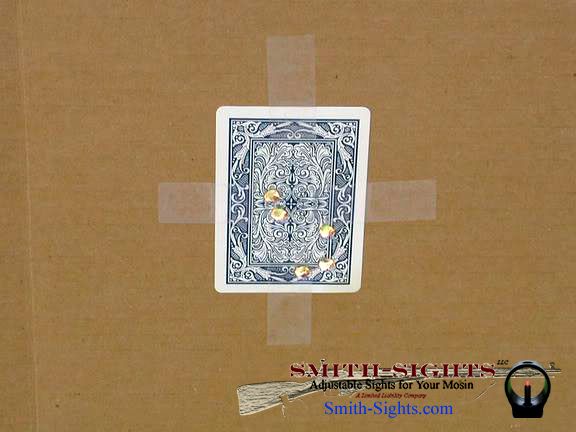
Here is a closer view. All shots fired stayed on the playing card with no real flyer.
Next came the penetration tests. I had two barriers with me today: a piece of inch thick hardwood and two sheets of drywall. The sheets of drywall together equaled ½".<br>
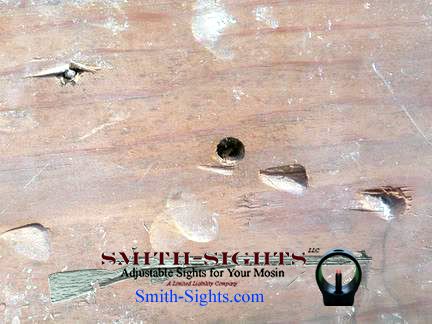
Here is the entrance hole on the oak.
I liked that entrance hole. I had never shot wood before that showed a circle as concentric as this.
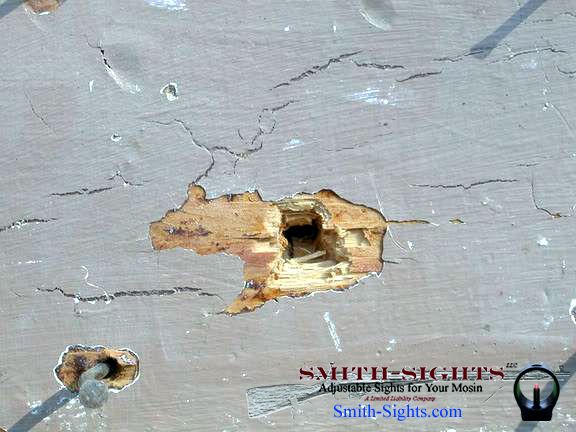
This is the exit hole. Notice how much larger it is than the entrance. This seems to indicate that the bullet was already beginning to deform.
Deformation was suspected in wood, a trait which I’ve not seen shared by the traditional hollow point as it needs external hydrodynamic pressure to influence expansion/deformation. I decided to forego the test with the drywall as it would have been worse than redundant to the wood.
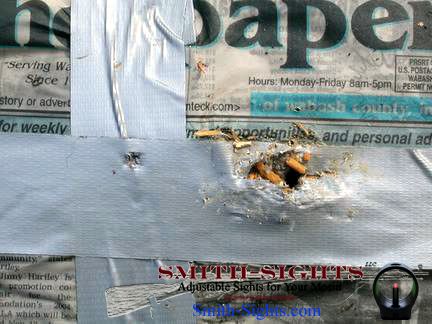
These are the wetpack entrance holes. The barely visible hole on the left was shot while the wetpack was naked. The one on the right shows the beginnings of expansion after the bullet passed through the wood.
Before I show the exit holes I would like to apologize as I could not manage to show the insides. Suffice to say both are perfectly conical showing uniform expansion. I particularly admire the fact that this ammunition can do this well after passing through a not informidable barrier.

The exit hole on the left was what the barrier penetrator made. The one on the right was bare wetpack.
In a day or two I will head out to the range again with a thicker wetpack. This one proved too thin though it did show how readily these rounds will expand. The new wetpack is soaking as I type this. I would also like to take a frontal shot on a racoon but I do not know if I will be given the chance.
Thus far I am favorably impressed with this ammunition. The recoil, while a bit sharp, is very quick. This to me is more important to bringing my pistol to bear again after recoil than a light, long “shove” type recoil.
I do not feel handicapped in the least by carrying Federal’s Expanding Full Metal Jacket over traditional hollow point ammunition.
Joshua M. Smith
Special thanks to Mr. Stephen A. Camp, Federal Cartridge Company and their excellent customer service, and to the members of Handguns and Ammunition who made me curious enough to start testing ammo a bit more seriously.
www.hipowersandhandguns.com
www.federalcartridge.com


